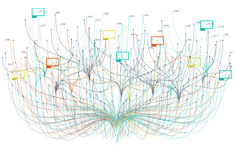Imagine being at the forefront of technological breakthroughs—pioneering AI and machine learning innovations. That’s the power of data annotation. This process, essential for training AI models, is not just a job; it’s a gateway to shaping our future. As AI applications expand further into diverse fields like natural language processing (NLP), autonomous driving, and medical diagnostics, your role in data annotation becomes increasingly vital.
By becoming a data annotator, you’re not just tagging data; you’re contributing to the development of technologies that will define our future. Your role is crucial, from enhancing the capabilities of virtual assistants to enabling autonomous vehicles to navigate safely. Data annotation transforms raw data into meaningful insights, enabling AI systems to understand and interpret the world more accurately.
This career path isn’t just about being part of the cutting edge of technology; it’s about creating it. It’s a unique opportunity to contribute to the future while enjoying a stable and rewarding profession in an ever-evolving industry.
So, who are data annotators, why are they so important and why you should consider it as a career path? Let’s dive in and explore the fascinating world of data annotation and its potential impact on you and our future.
Who are Data Annotators, and what is their role?
Data annotators provide a practical interpretation of real-world circumstances by AI systems. In this procedure, several data types, including text, audio, and images, are marked by human annotators or automated systems.
Data annotators play a crucial role in the development of AI technology. Their aim is to ensure high-quality annotations, which, in turn, lead to better models and stimulate innovation. With precise annotation, AI systems can achieve the accuracy and reliability needed for practical use, thus improving a company’s technology using data. This underscores the importance of data annotators in the tech industry and the potential for career growth in this field.
Therefore, people can earn vast amounts of money in this study area. Let’s dive in to understand how to earn money with data annotation!
Why is Data Annotation One of the High-Paying Remote Jobs?
Data annotation jobs offer not just precise compensation but also limitless benefits. The flexibility to choose your own pace and tasks based on your abilities and interests makes it a fulfilling career choice. Whether you’re a stay-at-home parent, a student, or someone seeking a side gig, data annotation can provide a promising career path. Depending on your capability, you could work as a data annotation professional and potentially earn up to $100 a day.
Before proceeding further, if you are keen on modifying automated models and have related skills, check out the information below to get started with data annotation as a career.
Essential Steps to Start Your Data Annotation Career
Relevant skills with an Educational Background:
Anyone interested in a career in data annotation should possess a set of specific skills. While a high school diploma is often the minimum requirement for entry-level data annotation jobs, the most crucial factor is the candidate’s abilities and knowledge in the relevant field. It’s perfectly acceptable if you don’t have a degree in data annotation, but you should aim to acquire specific certified skills. These skills include a high level of attention to detail, basic computer skills, knowledge of machine learning and artificial intelligence, and language proficiency.
Mandatory Skills –
- Pay attention to detail: Training AI requires accurate annotation.
- Basic Computer Skills: It’s imperative to have basic knowledge of computers and software.
- Knowing Machine Learning and Artificial Intelligence: The profound knowledge and understanding of AI/ML will help you identify how AI models use annotated data.
- Language Proficiency: Text annotation requires a high level of Language expertise.
Practical Experience is highly appreciated:
If you’re new to data annotation and eager to gain practical experience, various opportunities are available. Consider trying contract-based projects, freelancing, or crowdsourcing. These experiences will not only enhance your portfolio but also boost your confidence in your abilities, paving the way for future career growth.
Build a Portfolio that resonates with your Experience:
Build a portfolio of your work as you acquire Experience. This should highlight a range of annotation assignments you’ve finished, showcasing your versatility with various data types.
Data annotation is a complex task involving various segmented data and their types. A data annotator should learn different data types and use accurate technologies and tools for each type, ensuring the precise quality and relevance of the annotations.
The Must Learn Common Types of Data Annotation Tasks for Candidates
Image Annotation
An AI or ML model is trained by labelling photos, known as an image annotation. Every picture can have its objects marked with data annotation. Depending on the use case, the visual may include more labels than necessary.
With annotated digital photos, for instance, a machine learning model can learn to comprehend images at a high level and interpret what it sees. Image annotation includes three types such as:
- Classification of pictures: Images are first classified using existing annotated images to help the machine-generated with annotated images to identify what each image represents.
- Object detection process: An extension of the classification of images is object recognition. The quantities and precise locations of the objects in the picture are accurately described. In object recognition, each entity is given a label, unlike in image classification, when a label is applied to the entire image. For instance, an image is classified as regardless of the time of day when it comes to image categorization. Various entities in an image, like a table, bicycle, or tree, can be independently tagged by object recognition.
- Segmentation is a complex division process that breaks the image into various segments, called image objects, to facilitate more accessible image analysis.
- Boundary identification: Using boundary recognition, a machine can be trained to recognize lines and splines, such as sidewalks, land borders, and traffic lanes. Recognizing boundaries is crucial for autonomous vehicles to operate safely. Drone programming, for instance, requires machine learning models to teach drones to follow specific paths and steer clear of possible hazards like power lines.
Text Annotation
Machines are trained to comprehend text better through text annotation. Chatbots, for instance, can recognize user requests using keywords taught to the system and provide answers. However, inaccurate annotations make the machine unlikely to offer a helpful answer.
An improved user experience is provided via enhanced text annotations. Using text annotation, specific terms, phrases, etc., are allocated to data points throughout the data annotation process. Thorough text annotations are essential for precise machine learning. Various kinds of text annotations include:
- Semantic annotation: With the help of semantic annotation, you can improve the data of unstructured content by labelling documents with relevant concepts. The computers can understand the relationship between a particular piece of metadata and a resource that has been semantically annotated.
- Intent annotation: Intent annotation helps you understand the intent by analyzing the text, whether it offers approval or a request.
- Sentiment annotation: Machine learning models are trained using sentiment annotation data to identify genuine emotions in the text. For instance, ML models may find the attitude and sentiment underlying language by reading consumer reviews of the products. Based on this understanding, they can describe the material as positive, negative, or neutral.
Video Annotation
Video annotation is the practice of categorizing video clips so that computer vision models can be trained to detect or identify things. It is the engine behind the most recent developments in machine learning, including facial recognition and driverless cars. However, for such applications to work correctly, much video data must be carefully tagged by humans involved in the loop.
Point to note: Data labelling and Data annotation are different. Also, the tasks of data labellers and data annotators are different.
Data annotation and Data labelling – Different Careers
“Data labelling” generally refers to a specific context where raw data items are assigned meanings so that machine learning algorithms can understand them. The annotation method here requires identifying and labelling particular items in the dataset.
While the above terms are usually used as equivalence in the general context of data preparation for machine learning, they refer to two different steps in the data preparation workflow.
Data Labeling
For instance, labelling images with objects (“tiger” or “dog”) and classifying the text according to its attitude (positive or negative), among other things. The fundamental purpose of data labelling is to correct the code of the machine program to enable it to learn and generate structured output from the unstructured data for supervised tasks where the data examples would be labelled.
Data Annotation
Data annotation aims to empower machine learning models by lowering the information level grain and thus adding extra particulars. Traditionally, these jobs are performed by data specialists, who are, fortunately, called data annotators. They go through the search process to correctly identify and annotate them. Such technologies go hand in hand to make machine learning datasets training effective and efficient for the end user.
To put it oppositely, data annotation is a more detailed and specific field of data labelling. It means improving the database context by making tags, types, or place comments on the data. In this case, labellers can decide to split the image into separate parts and specify the location of every particular object. They can also use bounding boxes to indicate the components in the image.
The Reason Behind the Rising Demand for Data Annotators
The growth of AI applications and Machine learning in different fields has increased the demand for data annotators. Because they are the only professionals who can help AI understand large amounts of data. Most firms are trying to hire data annotators to add value to their recent product listings and improve the advancement of technology.
As per recent statistics, the global data annotation tools market is estimated to reach $5.33 billion by 2030, growing at a compound annual growth rate (CAGR) of 26.3% from 2024 to 2030.
Data annotation career is filled with challenging tasks and varied assignments. Let’s have a look at it!
Challenges You Will Face in Data Annotation Career Route
Data annotation jobs offer income options and values, such as self-improvement and skill growth. Engaging in different data annotation tasks can add helpful Experience to your portfolio and develop a keen understanding of AI and machine learning. This career is characterized by the opportunities to engage in challenges and work with emerging technology, which forms the core of an annotator’s career.
Whether you are a new employee or looking to change jobs, data annotation offers a unique opportunity that combines technical provisions with actual engagements. Join the actively growing data annotation career, where you get paid and have fun while learning and working in AI.
FAQs
Q: What are data annotation tools?
Answer: A data annotation tool is a software application designed to assist in labelling data for machine learning models. A few data annotation tools are BasicAI, CVAT, Dataloop, Encord, Kili Technologies, Labelbox, V7 Labs and more. These tools helps you to identify precise, accurate quality text, video, or image with labelled datasets.
Q: Do you need help getting a data annotation job?
Answer: Getting an opportunity in the data annotation field is a manageable task if you know how to connect and build a network with people already in the AI/ML field of study. This will ultimately boost your recognition and thus will help you get an opportunity.
Q: Which market trends are dominating data annotation?
Answer: The growth of unstructured data, the emergence of large language models, the significance of annotating visual data, the influence of generative AI, automation of the labelling process, and stricter data requirements for AI systems are among the top developments.
Q: Why are remote data annotators important, and what are their requirements?
Answer: Annotating remote data is essential for AI model training and is used in many sectors. It provides possibilities for job advancement, flexibility, and remote employment. A bachelor’s degree in a relevant discipline and careful consideration are usually prerequisites.
Data Annotation: the Tech Field is Growing Due to Generative AI
Jobs as data annotators have exciting prospects for anyone enthusiastic about machine learning and artificial intelligence. The possibility for career advancement in this field is increasing with the demand for expertise in data annotation.
However, people who work remotely are secure, and care is taken to ensure that all workers are adequately paid, as it is a fundamental requirement for the industry. Since AI technology is constantly progressing, there will be no escape from the need for remote data annotation, making it a highly appealing profession for those aiming for the remuneration and inescapable fulfillment of meaningful work.
Data annotator jobs are great for people wanting to join this quickly developing sector. They offer a rewarding career and the possibility of contributing to the development of the cutting-edge area of data annotation. If you need help annotating data or have any queries about SmartOne’s data annotation services, feel free to contact us anytime. We are more than happy to chat with prospective data annotators.
References:
https://time.com/6962608/data-annotation-legit-tech-jobs-ai/
https://www.cloudfactory.com/data-annotation-tool-guide
https://toloka.ai/blog/what-does-a-data-annotator-do/










